Record on the Road Lands in Los Angeles to Examine the City’s Changing Cultural Landscape

From left to right: RECORD editor in chief Josephine Minutillo, The Colburn School CEO Sel Kardan, Lucas Museum CEO Sandra Jackson-Dumont, architects Michael Maltzan and Sharon Johnston. Photo © Architectural Record
Los Angeles has been experiencing something of a cultural evolution. Although closely intertwined with the movie industry since the early 20th century, the city is becoming increasingly a center for arts and culture of all kinds. Some projects currently under construction include the enormous Lucas Museum of Narrative Art by Beijing-based MAD Architects, and an expansion and renovation of the Natural History Museum by Frederick Fisher and Partners, both in Exposition Park. Across town, the controversial Peter Zumthor-designed addition to LACMA is taking shape, while plans to overhaul the La Brea Tar Pits just next door to LACMA continue to develop. In yet another part of L.A., the Hammer Museum completed a decades-long building project earlier this year, designed by Michael Maltzan Architecture, just ahead of the recent opening of BAR Architects’ renovation of the UCLA Nimoy Theater (formerly the Crest movie theater) across the street in Westwood.

1

2
Rendering (1) of the MAD-designed Lucas Museum, currently under construction (2) in L.A.'s Exposition Park. Images courtesy the museum (1); © Hunter Kerhart (2)
This fall, the Walt Disney Concert Hall, home of the L.A. Philharmonic, celebrated its 20th anniversary. That audacious building, designed by Gehry Partners, was followed in 2015 by the Broad, another groundbreaking structure just down the block, by Diller Scofidio + Renfro. Nearby, The Colburn School, first conceived by Hardy Holtzman Pfeiffer in 1998, is ready to break ground with a Gehry Partners’ expansion in early 2024. The school, a leader in performing arts education, continues the physical and cultural transformation of this small stretch of downtown Los Angeles.
Sel Kardan, CEO of The Colburn School, along with Sandra Jackson-Dumont, CEO of the Lucas Museum, which is tentatively scheduled to open in 2025, joined RECORD last week at The Colburn School for a conversation about the city’s changing cultural landscape. It is part of a series of RECORD talks on the future of museums and cultural institutions initiated last March in New York.
RECORD editor in chief Josephine Minutillo moderated the L.A. discussion, which also included architects Michael Maltzan and Sharon Johnston, who presented arts projects they have designed throughout the city over the last few decades.

A rendering of the theater inside The Colburn School’s new addition designed by Gehry Partners. Image courtesy the Colburn School
“You can sometimes divide significant cities into one of two camps, great cities to make things in and great cities to see things in, and they're not always the same,” said Maltzan. “For the longest time Los Angeles was a better city to make things in. It was an incredible place, very supportive, and easy to have physical, emotional, and psychological freedom for making art. More recently it's become an amazing city to see things. But the cultural institutions are very conscious of the artistic community that lives here.”

Maltzan presenting with slide of 1990s Architectural Record cover featuring an early phase of his Inner City Arts. Photo © Architectural Record.
Maltzan, who talked about his recently completed work at the Hammer, as well as the multi-phased Inner City Arts not far from Skid Row, and Regen Projects in Hollywood, highlighted how these smaller-scale projects can ignite similar ones nearby, transforming neighborhoods. “I am really excited about how we curate cities—not necessarily just institutions,” added Jackson-Dumont, a recent transplant to Los Angeles. “L.A. has kept itself a secret in some ways to those outside the city."
Johnston similarly presented a series of smaller art galleries that her firm, Johnston Marklee, has completed throughout Los Angeles—including the just-opened Marian Goodman Gallery and art studios at UCLA. The efforts often involve refurbishing former industrial spaces. “There's this freedom in L.A. with real estate where you just create big spaces and artists respond to that,” Johnston commented. “There's something about this sort of fabric that we're working in, this industrial landscape, that's really accommodating to that kind of practice of making, presenting, collaborating, and working in different media.”
“There's a wonderful blurring of lines here,” Kardan added about the performing arts. “When you look at the Disney Concert Hall, it was thought of as a purely acoustic space where only acoustic music would be performed. And now something like 40-percent of music played there has some form of amplification. So, as we are looking at our new space—yes, it's an acoustic hall with great natural acoustics—we know it's going to be used by all kinds of musicians and performers because we've seen what's happened at Disney.”
This program was made possible by the generous support of sponsors Equitone, Safti, and Hydrotech.

.jpg?height=200&t=1713468361&width=200)



